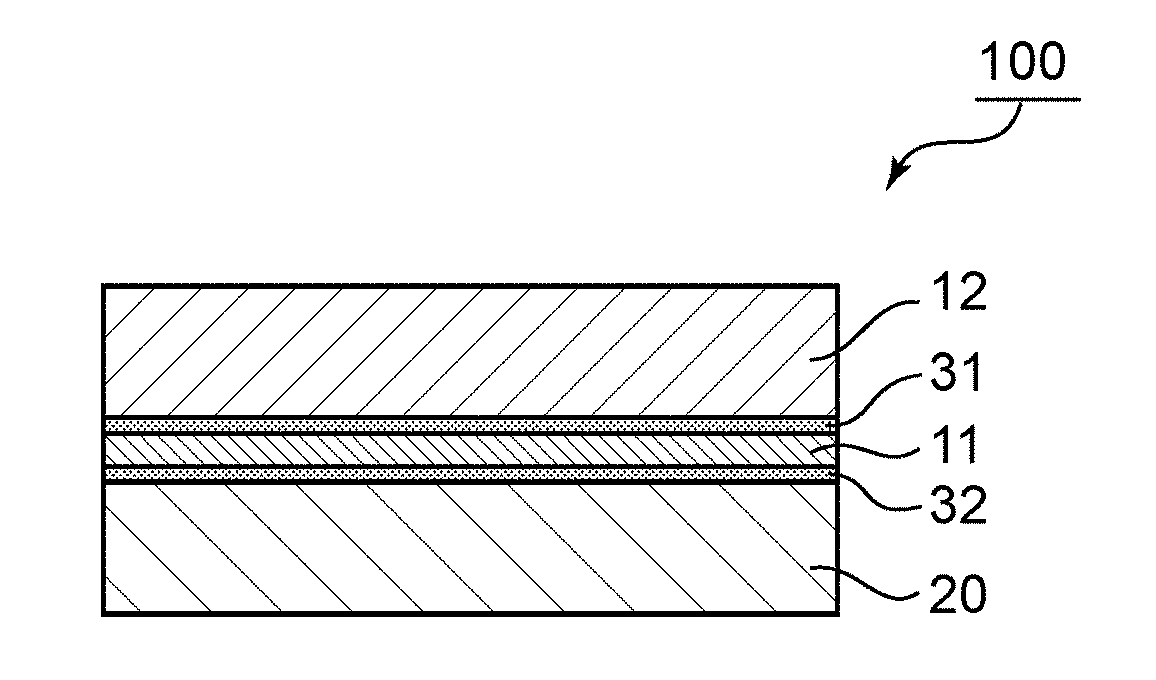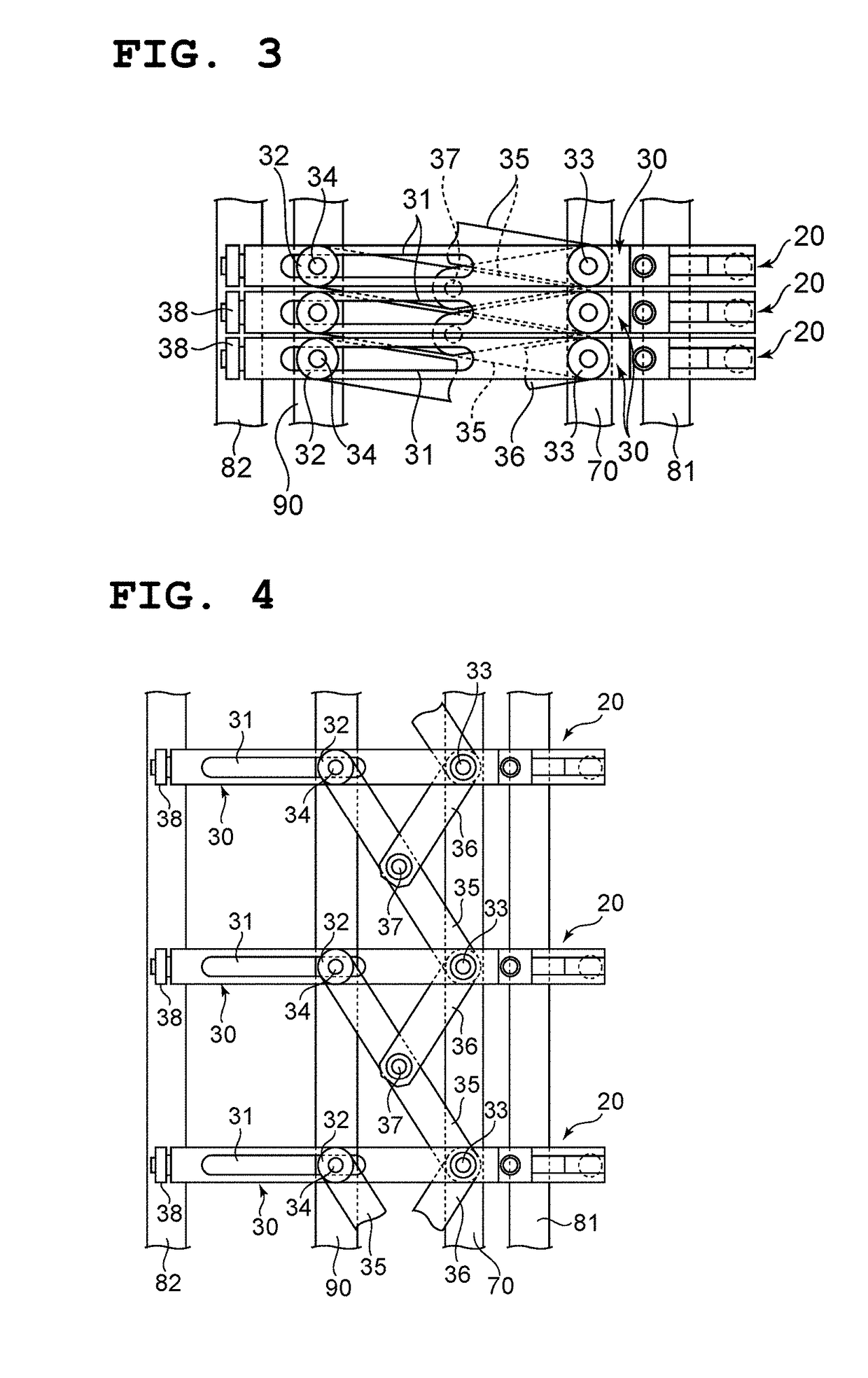Polarizing plate with phase-difference layer and image display device
a technology of phase difference layer and polarizing plate, which is applied in the direction of polarizing elements, instruments, optics, etc., can solve the problems of insufficient durability of polarizing plate, which is typical of high temperature and high humidity, and achieves the effect of durabl
- Summary
- Abstract
- Description
- Claims
- Application Information
AI Technical Summary
Benefits of technology
Problems solved by technology
Method used
Image
Examples
reference example 1
dation Film Constituting Retardation Layer
1-1. Production of Polycarbonate Resin Film
[0124]26.2 Parts by mass of isosorbide (ISB), 100.5 parts by mass of 9,9-[4-(2-hydroxyethoxy)phenyl]fluorene (BHEPF), 10.7 parts by mass of 1,4-cyclohexanedimethanol (1,4-CHDM), 105.1 parts by mass of diphenylcarbonate (DPC), and 0.591 part by mass of cesium carbonate (0.2 mass % aqueous solution) serving as a catalyst were each loaded into a reaction vessel. Under a nitrogen atmosphere, as a first step of a reaction, the heating medium temperature of the reaction vessel was set to 150° C. and the raw materials were dissolved while being stirred as required (about 15 minutes).
[0125]Then, the pressure in the reaction vessel was changed from normal pressure to 13.3 kPa, and while the heating medium temperature of the reaction vessel was increased to 190° C. in 1 hour, generated phenol was taken out of the reaction vessel.
[0126]The temperature in the reaction vessel was kept at 190° C. for 15 minutes. ...
reference example 2
dation Film Constituting Retardation Layer
2-1. Production of Polycarbonate Resin Film
[0131]445.1 Parts by weight of ISB, 906.2 parts by weight of BHEPF, 15.4 parts by weight of polyethylene glycol having a molecular weight of 1,000 (hereinafter sometimes abbreviated as “PEG#1000”), 1,120.4 parts by weight of DPC, and 6.27 parts by weight of cesium carbonate (0.2 wt % aqueous solution) serving as a catalyst were each loaded into a reaction vessel. Under a nitrogen atmosphere, as a first step of a reaction, the heating medium temperature of the reaction vessel was set to 150° C. and the raw materials were dissolved while being stirred as required (about 15 minutes).
[0132]Then, the pressure in the reaction vessel was changed from normal pressure to 13.3 kPa, and while the heating medium temperature of the reaction vessel was increased to 190° C. in 1 hour, generated phenol was taken out of the reaction vessel.
[0133]The temperature in the reaction vessel was kept at 190° C. for 15 minut...
reference example 3
dation Film Constituting Retardation Layer
[0137]Polymerization was performed with a batch polymerization apparatus formed of two vertical reactors each including a stirring blade and a reflux condenser controlled to 100° C. 9, 9-[4-(2-Hydroxyethoxy)phenyl]fluorene (BHEPF), isosorbide (ISB), diethylene glycol (DEG), diphenyl carbonate (DPC), and magnesium acetate tetrahydrate were loaded at a molar ratio of BHEPF / ISB / DEG / DPC / magnesium acetate=0.348 / 0.490 / 0.162 / 1.005 / 1.00×10−5. The inside of a first reactor was sufficiently purged with nitrogen (oxygen concentration: 0.0005 vol % to 0.001 vol %), and then heated with a heating medium. When the internal temperature reached 100° C., stirring was started. The internal temperature was caused to reach 220° C. after 40 minutes from the start of the temperature increase, and while the temperature was controlled to be kept at this temperature, pressure reduction was simultaneously started, and the pressure was caused to reach 13.3 kPa in 90 m...
PUM
| Property | Measurement | Unit |
|---|---|---|
| transmittance | aaaaa | aaaaa |
| transmittance | aaaaa | aaaaa |
| thickness | aaaaa | aaaaa |
Abstract
Description
Claims
Application Information
 Login to View More
Login to View More - R&D
- Intellectual Property
- Life Sciences
- Materials
- Tech Scout
- Unparalleled Data Quality
- Higher Quality Content
- 60% Fewer Hallucinations
Browse by: Latest US Patents, China's latest patents, Technical Efficacy Thesaurus, Application Domain, Technology Topic, Popular Technical Reports.
© 2025 PatSnap. All rights reserved.Legal|Privacy policy|Modern Slavery Act Transparency Statement|Sitemap|About US| Contact US: help@patsnap.com



